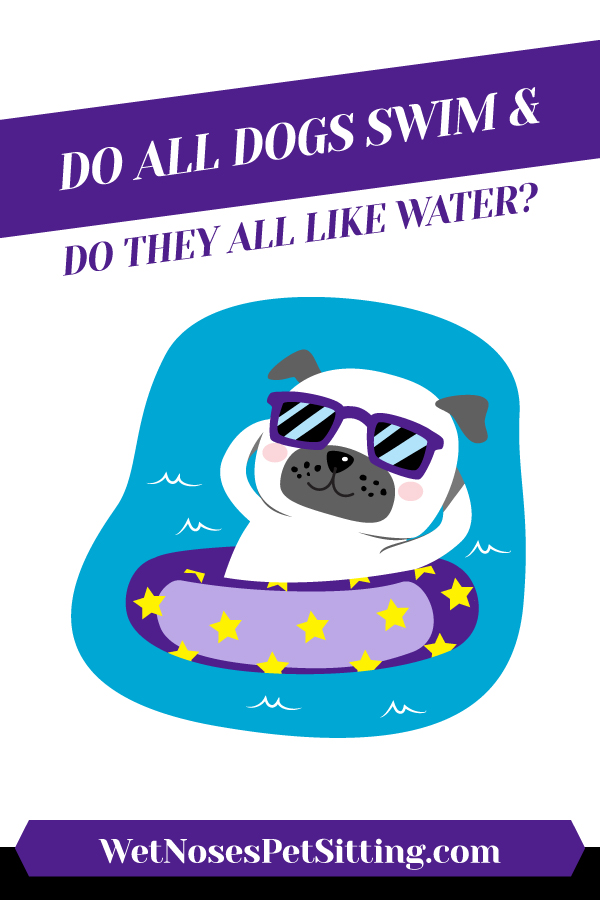Do All Dogs Swim & Do They All Like Water?
Do All Dogs Swim & Do They All Like Water?
The questions above are valid, and should be explored when looking to see if a particular dog is the right fit for their family. Many homeowners have backyard pools, or live near the ocean and other large bodies of water. While there are many dogs that are natural swimmers, there are some that may need a bit of training in order to keep them water safe, and still others that are probably not going to be safe anywhere near water.
More and more dog owners really enjoy going hiking and camping and they love sharing that experience with their beloved pet! When we are finished here, hopefully you are going to have a better idea what dogs are the safest to have around lakes, streams and other large bodies of water.
I think it is safe to say that there are some breeds of dog that just do not like water. First off we will look at those specific dogs that don’t like the water or are not very good swimmers. Secondly, we will see what breed of dogs like being in the water, and then we’ll conclude with the answer to the question of “Do All Dogs Swim?”
Dog breeds that are not the best for swimming
The flattened snout of the Pug with their unusually narrow trachea and nasal passages along with a long soft palate can cause the airway to restrict, causing panic and stress in water. While a particular pug may like the water, many just can’t get enough air into their lungs with the added effort needed to stay afloat.
French Bulldogs again are short snouted and have similar issues as the Pug. They have wide chests and shorter legs and their body type is dense. Most Frenchies do not like water and owners are wise to secure their dog around water with a personal restraint or fencing that they cannot get through.
Dachshunds can and do love the water but owners should always supervise them. With their long bodies and short legs it can be difficult to keep their heads above water. Like the Pug and French Bulldogs the Dachshunds can be made safer in the water if they like it, by using an approved and well fitting dog life vest.
Low body fat dogs like Whippet, Dobermans, and Greyhounds are not as buoyant and may not take to the water very well. The Staffordshire Bull Terrier like other bully types have large heavy heads that make it hard to keep their noses above the water.
While the Basset Hound is adorable with those big floppy ears, it’s their short legs and large heavy body that can cause them to sink more than swim. Since they have those droopy ears they tend to have issues with ear infections so being in the water may not be the best bet for these wonderful hounds.
Smaller dogs like the Maltese, Yorkie and Pomeranians have the problem of small trachea that can collapse with over exertion. Swimming can be strenuous so it is best if these cute little guys and gals stay high and dry on land!
Dog breeds that love to swim
The Portuguese Water Dog is a working dog and fisherman’s friend! They can range from 35 pounds for a female up to 60 pounds for a male. Their smaller size makes them an ideal boating companion. They have wavy or tightly curled coats and have energy and enthusiasm that makes them ideal for dock-diving competition or an all around happy fun companion!
Did you know that the Poodle is a water dog? “Pudl” is German for to splash in water! They are bred to retrieve and have a curly dense single layer coat that comes in any number of colors. The toy is about 5 pounds, the miniature is approximately 12 pounds and the standard size can weigh up to 70 pounds. This breed is a favorite with families no matter what size you get them in!
Labrador Retrievers are consistently a favorite among families with children. They love to please their people and it can be a full time job keeping them OUT of the water! This wonderful sporting dog has a dense but smooth water resistant coat that comes in black, yellow or chocolate. They tend to be in the 70-90 pound weight range, so be sure that you allow plenty of room for them and consistent time for their exercise.
The Newfoundland is an expert and powerful swimmer. This breed thrives on water rescues and have worked side by side with fishermen for many years. Their coat lies flat and is medium length but thick. This is a large dog with the males weighing in at up to 150 pounds. Newfoundland’s are loyal dogs that truly love being in and around water everyday!
Chesapeake Bay Retrievers or Chessie is known for its waterproof coat. They have a strong mind and soft mouth that compliment their wavy coats and bright eyes. Males can be up to 80 pounds and have an average energy level. Plenty of positive training will keep this pup happy all day long.
The Golden Retriever is an intelligent, tolerant working dog that fits very well within families. They are easy to train but have a high energy level and need plenty of exercise especially in the water! They are pretty average in size for a large dog. Most weigh around 70 pounds.
Do all dogs swim?
Well, I think we have discovered that there are several dog breeds that may not be the best suited for being in the water. The ones with small stout noses and those with low body fat are just not as adaptable and therefore would not benefit from being in the water. Not all dogs know how to swim. They may love the water but have no idea how to navigate in it.
Remember it’s wise to carefully research the physical capabilities and other strengths of the breed before you bring them home to your family. Knowing the energy levels, body density and overall tendencies of a particular breed will aid you in finding the perfect fit for your lifestyle.
As with anything new, you will want to introduce your dog to water and swimming in a positive way. By taking the time at the very beginning you will help them feel more confident in the water.
Start by introducing them to the shallower water first, let them get comfortable with the temperature of the water. Too cold water can adversely affect your dog. Give them time to adjust to the feel of the ground under them. Sometimes there are big slippery rocks and other times it’s muddy and slimy. It’s also important that you always supervise your dog in and around water, even the best swimmers can encounter fatigue, get caught or stuck on something or become stressed while swimming.
Preventative measures such as having your dog outfitted with a dog life preserver, even for strong swimmers is a great way to keep your dog safe in the water. Drying your dog’s ears after their time in the water will help to prevent ear infections.
Check with your veterinarian about preventative measures for waterborne bacteria and or parasites. Make sure you provide flea and tick protection in the forested and grassland areas you will be hiking through. Also, know the area you will be swimming in and be aware of any water predators like, poisonous snakes, alligators or even sharks.
Conclusion
In closing we want you to have a safe and wonderful time in the water. Enjoying your dog’s enthusiasm for swimming and playing in the water will strengthen your bond and provide years of cool, wet fun!














